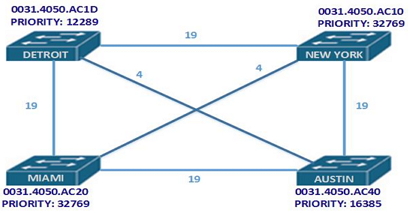For today’s CCENT / CCNA certification exam topic we are going to cover Spanning Tree Protocol. STP is one of the more confusing topics you may encounter on the CCENT and CCNA exams. I think most of the reason STP is a difficult topic for most is that the student is suffering from information overload by the time they study all the material Cisco wants you to know for the exam. That is why many students do find that it is best to break up the Cisco Routing and Switching certification topics into two exams: ICND1 which gives you the CCENT certification and ICND2 which gives you your CCNA certification.
So let’s talk a little bit about Switching and the Cisco exam. Switching and the related concepts have really come for the forefront on the exams as of late. You really need to be able to look at a network topology diagram like you see here and be able to interpret it. That is what we hope to help you with in this article.
So take a look at the four switches that we have noted above. Also pay special attention to how they are cabled as that is going to give you some great insight on how to approach these exam questions that were designed to trip you up! So let’s see if you really understand Spanning Tree Protocol.

CCENT/ CCNA Spanning Tree Protocol
Refer to the exhibit. Based on the information given, which switch will be elected root bridge and why?
A. Switch NEW YORK, because it has the lowest MAC address
B. Switch MIAMI, because it is the most centrally located switch
C. Switch DETROIT, because it has the lowest priority
D. Switch AUSTIN, because it is the most centrally located switch
E. Switch DETROIT, because it has the highest MAC address
F. Switch NEW YORK, because it has the highest priority and the lowest MAC address
Theory
– If you already know the answer, that is great. But if not, let’s walk through a bit of STP theory and then go over each of the questions one by one to see if you can then determine the correct answer from some of the help we will provide below.
Spanning Tree Protocol (STP) is a loop prevention in a redundant switched network by ensuring that there is only one logical path between all destinations on the network by intentionally blocking redundant paths that could cause a loop. The switch sends BPDUs (Bridge Protocol Data Units) out every active port once every 2 seconds so as to find a redundant link. Redundant links are found when the switch receives its own BPDU.
The spanning tree algorithm, chooses a single switch as the root bridge and it uses it as a reference for all path calculation. The switch with the lowest Bridge ID (BID) is usually elected as the root bridge and none of its ports are blocked.
The root bridge is determined by the switches’ mac address (lower is better), and the priority which is 32769 by default which is increments of 4096 (lower is better), then the cost of the link which is the bandwidth, and finally the lower port on a switch.
All ports on the root bridge are designated ports and will never be blocked, there is always 1 designated port per link.
Root ports are the best paths to the root bridge while the other ports which are neither root ports nor designated ports are blocked to avoid loops.
In this scenario, SWITCH DETROIT is the root bridge since it has the lowest priority and thus a lower BID. All ports on other switches that connect to SWITCH DETROIT are root ports. The ports on SWITCH DETROIT are designated ports.
The link costs in STP are shown below.
| DATA RATE | STP COST |
| 4 Mb/s | 250 |
| 10 Mb/s | 100 |
| 16 Mb/s | 62 |
| 100 Mb/s | 19 |
| 1 Gb/s | 4 |
| 2 Gb/s | 3 |
| 10Gb/s | 2 |
So from our explanation you should have come up with the answer of C. Switch Detroit because it has the lowest priority. For more detailed information on root bridge election and port roles refer to the CCNA STP topic we have here. Then if you really want to accelerate your learning, see how it works in the real world with one of our home lab kits!
